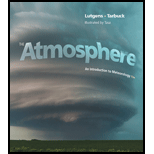
(a)
The elevation of the cloud base with reference to the accompanying figure.
(b)
The temperature of the ascending air as it reaches the top of the mountain.
(c)
The dew-point temperature of the rising air at the top of the mountain.
(d)
The amount of water vapor that must have condensed (in grams per kilogram) as the air moved from the cloud base to the top of the mountain.
(e)
The temperature of the air if it descends to point G.
(f)
The approximate capacity of the air to hold water vapor at point G.
(g)
The relative humidity at point G, assuming that there was neither addition nor subtraction of moisture to or from the air when it moved downhill.
(h)
The approximate relative humidity at point A, using the dew-point temperature at the lifting condensation level for the surface dew point.
(i)
Two reasons for the difference in relative humidity between points A and G.
(j)
The term that describes the situation of Needles, California, which is situated on the dry leeward side of a mountain range similar to the position of point G.
Want to see the full answer?
Check out a sample textbook solution
Chapter 4 Solutions
The Atmosphere: An Introduction to Meteorology (13th Edition) (MasteringMeteorology Series)
- Provide examples to illustrate the effects of glacier and ice sheet melting on climate globally and regionally. Use words to illustrate any feedback mechanisms between melting ice sheets and the climate.arrow_forwardUse diagrams and word explanations to show how excess heat from the tropics is transferred to higher latitudes (discuss cells and ciruclations) . Additionally, show how the broadening of the Hadley Cell, caused by rising greenhouse gases, could affect surface climate in subtropical and mid-latitude regions.arrow_forwardExplain why the Earth is in not in radiative equilibriumarrow_forward
- Showing the energy flows into and out of Earth’s atmosphere with energy sketches. Clearly label each flow for what it represents, distinguishing between solar and terrestrial energy flows. Explain the diagrams in more detailsarrow_forward44) In periglacial environments, the layer of ground that thaws every summer and freezes every winter is called A) frost layer B) permafrost C) active layer D) discontinuous permafrostarrow_forwardUse the attached piezometer map to make your own, clean version of the map, and indicate the elevation of the water table at all piezometer locations. Draw equipotential lines (lines of equal water table elevation) using regular intervals – creating a contoured map of the water table. Determine the direction of groundwater flow based on the horizontal gradient. Label the areas of recharge and discharge directly on your map. Flow lines: Draw flow lines on your water table map. The lines should be at right angles to the equipotential lines and extend from the recharge area to the discharge area. Hydraulic Gradient, Specific Discharge (Darcy Flux), Average Linear Velocity: Using your water table map, estimate an average hydraulic gradient between two locations, call them locations A and B, one at the eastern-most and a second at the western-most extent of your dataset (note the north arrow on the map). Calculate the specific discharge, q, between the two locations. For this calculation…arrow_forward
- <task> Solve the task by identifying the type of grain found in the black-highlighted areas on the map and provide two factors influencing its distribution.</task> <instructions> <instruction>Analyze the map: First, carefully examine the highlighted areas on the map. Pay attention to the continents and regions where these areas are located. Try to identify the general climate zones in which these areas fall.</instruction> <instruction>Consider the types of grain: Think about different kinds of grains and their climatic and geographical preferences worldwide. What grains are cultivated in the highlighted regions?</instruction> <instruction>Use additional clues (if available): If you have supplementary images with various grains, compare their distribution with the map in the task. This could help narrow down the possibilities.</instruction> <instruction>Select the most likely grain: Based on the map analysis and…arrow_forward41) Alpine glaciers A) are the largest types of glaciers. B) conform to the shape of the landscape. C) cover large sections of continents. D) show no relationship with the underlying topography.arrow_forward39) Translatory waves A) are the types of waves located furthest away from the shore. B) are slowed down by friction with the bottom of the ocean. C) move water particles in perfectly circular orbits. D) do not interact with the bottom of the ocean.arrow_forward
 Applications and Investigations in Earth Science ...Earth ScienceISBN:9780134746241Author:Edward J. Tarbuck, Frederick K. Lutgens, Dennis G. TasaPublisher:PEARSON
Applications and Investigations in Earth Science ...Earth ScienceISBN:9780134746241Author:Edward J. Tarbuck, Frederick K. Lutgens, Dennis G. TasaPublisher:PEARSON Exercises for Weather & Climate (9th Edition)Earth ScienceISBN:9780134041360Author:Greg CarbonePublisher:PEARSON
Exercises for Weather & Climate (9th Edition)Earth ScienceISBN:9780134041360Author:Greg CarbonePublisher:PEARSON Environmental ScienceEarth ScienceISBN:9781260153125Author:William P Cunningham Prof., Mary Ann Cunningham ProfessorPublisher:McGraw-Hill Education
Environmental ScienceEarth ScienceISBN:9781260153125Author:William P Cunningham Prof., Mary Ann Cunningham ProfessorPublisher:McGraw-Hill Education Earth Science (15th Edition)Earth ScienceISBN:9780134543536Author:Edward J. Tarbuck, Frederick K. Lutgens, Dennis G. TasaPublisher:PEARSON
Earth Science (15th Edition)Earth ScienceISBN:9780134543536Author:Edward J. Tarbuck, Frederick K. Lutgens, Dennis G. TasaPublisher:PEARSON Environmental Science (MindTap Course List)Earth ScienceISBN:9781337569613Author:G. Tyler Miller, Scott SpoolmanPublisher:Cengage Learning
Environmental Science (MindTap Course List)Earth ScienceISBN:9781337569613Author:G. Tyler Miller, Scott SpoolmanPublisher:Cengage Learning Physical GeologyEarth ScienceISBN:9781259916823Author:Plummer, Charles C., CARLSON, Diane H., Hammersley, LisaPublisher:Mcgraw-hill Education,
Physical GeologyEarth ScienceISBN:9781259916823Author:Plummer, Charles C., CARLSON, Diane H., Hammersley, LisaPublisher:Mcgraw-hill Education,





